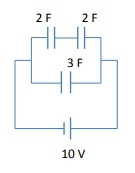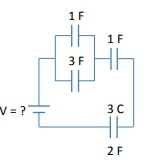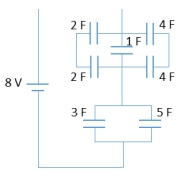All right, guys. So for this video, we're going to be working on how you solve problems with capacitor circuits. Let's go ahead and check it out. Because we saw that in circuit problems, we could figure out what the equivalent capacitance is of the entire circuit. But now you're gonna be asked things like what are the charges and voltages across some combinations of capacitors. You're gonna need to know how to figure that out.
So we saw from the last video that if you have series connections, you can figure out what the equivalent capacitance is by using these rules. We have for series connections, the inverse sum rule, where you basically take the inverse of the equivalent capacitance, and it's equal to the inverse sums of all the individual capacitors. Right? So if you have all of these capacitors that are in a line like this, remember that these capacitors mean that there are some charges that are building up on the plates between them. There's negative and positive charges, and they're separated by some distance. What ends up happening is that one of the capacitors builds up a charge and it transfers that charge to the next one in line, and that one transfers the charge to the next one in line as well. So basically, what happens is that capacitors in series will share charge with each other. So that means if you have a capacitor that has 3 coulombs of charge built up between the plates, then that means that there are 3 coulombs on the next plate and also on the next capacitor. So all of those charges basically pick up 3 coulombs each. And it also means that when you condense this down to one equivalent capacitance, \(C_{EQ}\), then that will also have a 3 coulomb charge. So in other words, these share charge with the equivalent capacitance. So that's how series connections work. They always share the same charge, and that's always going to be true.
Now we also saw that for parallel connections, we could figure out what the equivalent capacitance is, and it's basically just the sums of all of those things. So if you have parallel connections, the equivalent is just summing each of the individual capacitors. Now what happens is if you have this wire and you have it approach this junction and the wire splits off into these three parts, what happens is you can you can imagine these charges sort of branching off in different directions. So what ends up happening is that the charge is not conserved and the charge is not flowing through each one of these things equally. It has to split up. But what ends up happening is that through these points right here, from this point to this point and this point to this point, the potential difference is, in other words, those Vs are equal to each other. So unlike for series connections, capacitors in parallel don't share charge with each other, they share voltage with each other. So, whatever the voltage is across one of the capacitors, so I'm just gonna make up a number. If this is 2 volts, then that means that voltage is the same across all 3 capacitors. They don't share the same charge. So what that also means is that when you condense this down to an equivalent capacitor, \(C_{EQ}\), then that means that the voltage also has to be 2 volts. So you can actually work forwards and backwards from this kind of thinking. You can collapse all of these down to an equivalent capacitor and know what the voltage is, or you can take an equivalent capacitance and expand it back out into its individual capacitors, and you know what the voltage across each of those is. So you can sort of work forwards and backwards. Now with these rules, we basically have everything we need to solve capacitor circuits problems. And we have a nice step by step process to solve those things. Let's go ahead and check it out.
So we've been working with the first step a lot. We've found what the single equivalent capacitor is for a circuit. And, now what we have to do is questions will ask you things like, what is the voltage across this 3 farad capacitor? What is the charge across this combination of capacitors? So what we need to do is once we find these single equivalent capacitance out of the entire system, now what we need to do is use the relationships between \(Q\), \(C\), and \(V\) to figure out what the voltage and charge are for the entire circuit. And now what you can do is you can work backward and sort of expand out again that circuit until you figure out the voltages and charges for each of the capacitors that you're interested in. That's gonna be the step by step process. We're gonna reduce everything down to a single capacitor, figure out what the voltage and charges across this whole circuit are, and then we're gonna move outwards again, sort of expanding all of these capacitors until we find the variables that we're interested.
To see how all of this stuff works, we're gonna go ahead and do this example together. So, what's the charge and voltage of each of these capacitors in the following circuit? So we've got 3 capacitors. We've got a mixture of parallel and series. So we're gonna go ahead and first things first, we're going to find out what the equivalent capacitance is of the entire circuit. Now, we've done this before. We have these capacitors right here that are in series, but if you look a little bit more closely, we have this 1 and 2 farad capacitor that are in parallel. So we need to work from the inside out. So what happens is this system right here, this circuit can be thought of as this more simplified circuit where you have the equivalent capacitance over here, and then you have the 6 farad capacitor hooked up to the battery right up here. So we have this 10 volts. Now, in order to figure out what the equivalent capacitance is, \(C_{EQ}\), all we have to do is just add them because they are in parallel. So, in other words, these are in parallel, so the equivalent capacitance is just gonna be 2 plus 1, which is 3 farads. And we also have the original 6 farad capacitor right here. So now what happens is we need to figure out the equivalent capacitance. So that's gonna be when we do these capacitors in series, when we add these things in series together. So this is the same exact thing




